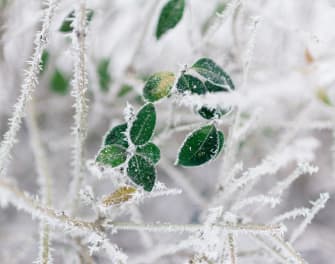Over the course of millions of years, most of the plant life in North America evolved to survive the long and difficult winters. However, the plants that we use for the landscape around our homes aren't always built to withstand that changes that occur over winter.
The issues may occur because the plants are tropical or because they haven't been in the ground long enough. Either way, our top four winter gardening tips will help maintain the lifespan of plants.

1. Prepare Your Garden
When you want to get your garden winter ready, start off with one final weeding. Later in the season, but before the ground starts to freeze, go through your garden and pull up all the weeds.
If weeds are left in your garden through the winter, they will be right there, ready to pop out of the ground come spring.
Go through and pick up all the debris around the garden and from your lawn. Leaving piles of leaves around increases the chances you will see pests and could develop diseases in the soil through the winter.
Separate leaves from diseased plants and shred the rest as mulch. Gather all of your leaves and put them into a shredder or else run over them with a lawnmower that has a bag attached.
A thorough clean up of your landscape will keep deer out of your garden as well. When you take away food sources, they won't be hanging around, munching on your plants. When you show that your garden is a reliable place to pick up snacks, you'll be attracting deer for generations.
2. Deal With Your Shrubs, Trees, and Perennials
When your lawn, your garden, or the space surrounding it is populated with many different types of plants, you need to take some precautions. They need to be protected but also pruned to a degree that keeps them from being too tasty for animals.
If you don't want or need them as holiday decorations, cut back on the perennials that you don't want over the winter.
Plants that end up turning black or mushy end up being the ones that harbor disease or insects throughout the winter. Cut back on all the branches that are going to suffer in high winds.
Once your perennials have gone dormant, work to cut back on any long branches, stems, canes, or anything you don't think is going to survive the winter.
Wrap any newly planted trees or shrubs. They're delicate during these early years of their life and dry winter wind is going to induce dehydration.
If your newly planted shrubs have weak or brittle branches or have easily damaged leaves, wrap them up in cheap burlap.
They'll retain a surprising amount of heat and continue to grow over the winter.
If you have newly planted shrubs, think about their root systems. Since they haven't had the time to reach deep into the soil and create strong roots, they'll struggle to get water to fix their damaged leaves.
Water them regularly until the first frost, and then use mulch around the bases to help them retain moisture and a little bit of heat.
3. Protect Your Plants in Containers
If you want to have plants in containers around your home or garden, look for plants that are stronger than those you put in the ground. Plants in containers are more fragile because their roots are more exposed to the elements than those in the ground. Large containers are going to offer a bit more insulation because there's more soil available, but they're still more susceptible to freezing.
Bring in any tender perennials or any plants you have that are tropical.
If you have perennials that aren't very tough, keep them in your basement or a garage and they'll go dormant. Plants that need to go through a temperature cycle in order to give you the blooms or fruits you're looking for should be left outside and protected.
If you want to keep your plants in containers, try burying your containers.
You'll end up keeping them insulated while staying able to pull them back out when winter ends. Huddle your plants together and keep your most sensitive plants at the center of the huddle, against your home or another building.
If you have plants in terracotta pots, layers of bubble wrap and burlap help to keep the moisture out. Water that collects and freezes causes your plants to become damaged or die.
4. Protect Your Lawn
If you want to protect your lawn, you'll keep your whole home and your property ready to shine as soon as spring hits. When you take care of your entire property, you create a better environment for all plant life.
When you want to get your lawn ready, start with the perfect fall fertilizer. An organic fertilizer high in potassium is perfect for a lawn about to be damaged by the winter.
Go to your local lawn and garden store and ask around about products that people rely on for winterizing the plant life on their property.
Before the winter hits, take the time to cut your grass down. Before the season ends, make one final cut to keep your grass around 2 inches tall. Tall grass harbors fungus and diseases.
Even when it's covered with snow, the grass underneath is teeming with life, bacteria, microbes, and other things that grow.
Lime is a dependable way to help your soil make the alkaline it needs during the winter. Adding lime means that as your lawn freezes and thaws, it'll get worked into the soil.
Winter Gardening Tips Involve Common Sense
Most of the winter gardening tips you need involve common sense but are overlooked because of the sensitive nature of plant life. However, with some diligence and focus, you'll have a garden that both thrives over winter and is prepared for the arrival of spring.
If you want a few winter houseplants to liven up your home, check out our latest guide.
